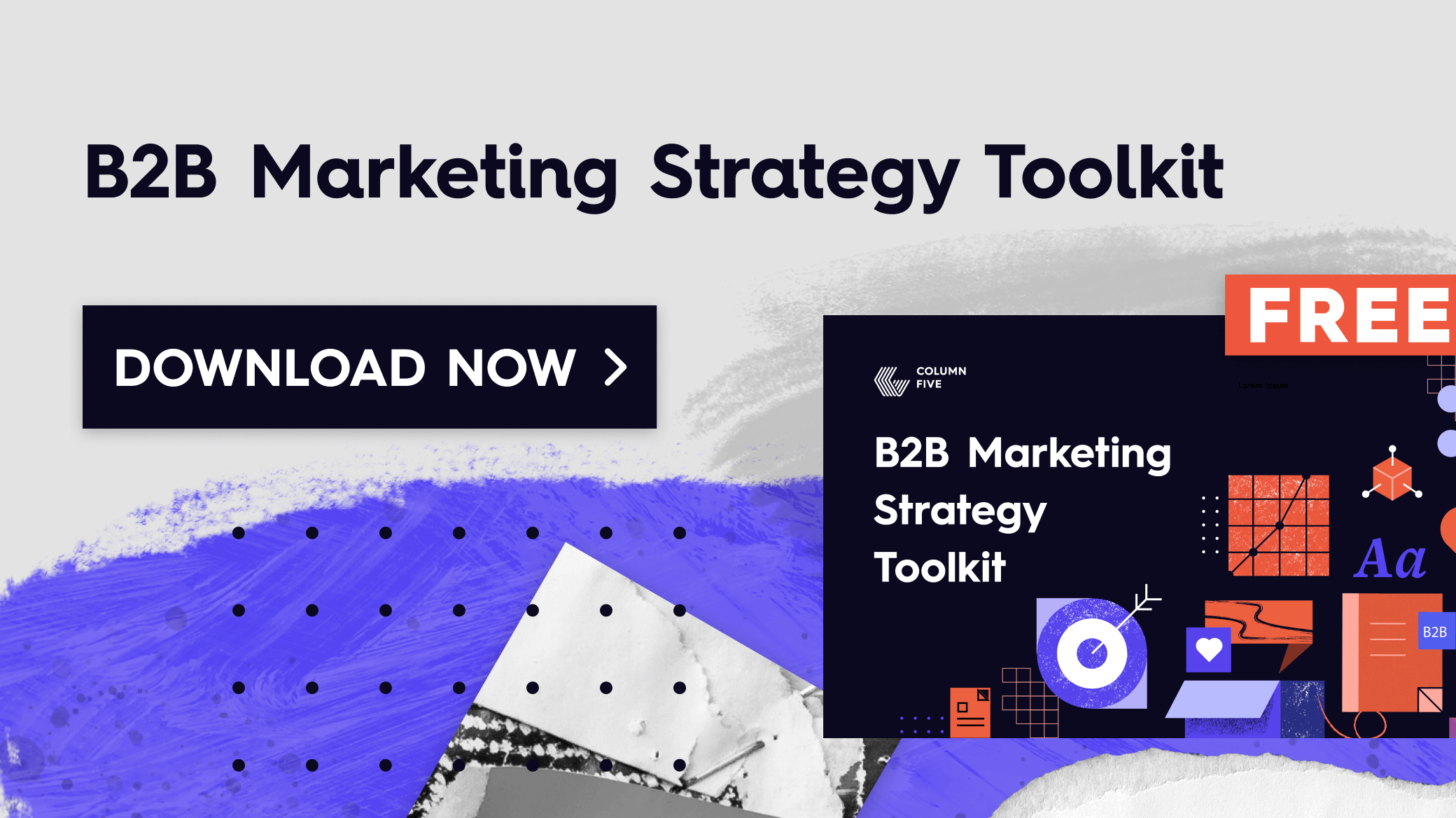SaaS marketing isn’t easy. Your customer pool is smaller, there is more competition, and the path to purchase is much longer. But when you’re unwittingly making mistakes that sabotage your success, it’s that much harder. Having worked with SaaS clients over the last decade, we’ve seen tons of well-intentioned brands make missteps (both small and big) that affect their marketing negatively. Luckily, we know exactly what those mistakes are and how to correct course if you’re making them.

How to Fix the Top 10 SaaS Marketing Mistakes
There are all sorts of ways you may be holding your brand back from doing your best marketing—even if you don’t realize it. From poor strategy to misguided newsjacking, here are the top 10 mistakes SaaS marketers make, plus easy fixes to get you back on the right track.
Mistake #1: Unclear positioning.
When clients come to us for content help, we always ask them about their core brand positioning: who they are, who they’re for, what they do, and why they’re different. Far too often, they can’t answer these questions succinctly. This is especially common in SaaS, where the most focus is spent on the product itself. But if you don’t have a crystal clear understanding of who you are and how you fit into the marketplace, your marketing will be scattershot and unable to help you establish a firm footing with your audience.
Tip: Do a competitive analysis to understand how your competition is positioning themselves—and how you can stand out.
Mistake #2: Having a content strategy—that lives in your head.
Only 46% of B2B tech marketers have a documented content strategy.
—Content Marketing Institute
This stat is completely shocking, but in our experience, it is far more common than one would think. Even if you’re working with a small team, your strategy can’t live inside one person’s head (or a few people’s, for that matter). There are too many moving parts and too many things to consider. This is why a weekly meeting to chat about priorities or to-do lists won’t cut it either.
To be successful in marketing, you need a documented, measurable strategy to guide your content, track progress, and identify opportunities to improve.
Although a strategy is a living, breathing thing that should evolve, you need something on paper to keep everyone, from your newest hire to your CMO, on the same page.
Tip: Use our free content strategy toolkit to build a simple, measurable strategy that works.
Mistake #3: Prioritizing product at the expense of brand.
It’s common for SaaS companies to have product-centric cultures, which is understandable if you’re in the early stages of your company. And product-market fit is certainly a critical hurdle that requires investment and focus. But in a competitive marketplace where features, bells, and whistles are quickly copied, it is your core brand that will help you differentiate and succeed long-term. Unfortunately, brand is often an afterthought, which makes marketing harder.
It’s only when you have a clear understanding of who you are, what you care about, and what you’re trying to achieve that you can effectively share your values and tell your story.
Tip: Use our free workbook to identify your brand heart, including your purpose, vision, mission, and value. This critical work will help you communicate your brand much more effectively to not only consumers but current employees, future employees, and industry peers.
Mistake #4: Ignoring your marketing fundamentals.
Sure, there are lots of flashy new marketing tactics like events/stunts and AI bots of every flavor out there. But every marketing department should focus on mastering the fundamentals first:
- Search
- Social
Good old-fashioned lead gen content and SEO can still carry the lion’s share of a fledgling marketing practice. But you need to invest in SES to make the most impact with your audience and create a content ecosystem that supports your goals.
Tip: Content marketing is about building and sustaining relationships through content, but you need that content to be seen first. See our guides to find your target audience and create a distribution plan that helps them find your content.
Mistake #5: Trying to do too much on social.
97% of tech marketers use LinkedIn to connect with their audience.
— Content Marketing Institute
Yes, social is a huge component of your marketing fundamentals, but you don’t have to be everywhere at once. Sure, you’ll want to keep tabs on new channels (and create your brand handle), but it’s better to do a few channels well than spread yourself thin.
In fact, not only do you not need to be on every channel but sometimes you can actually hurt your brand by trying to force your way into a space.
In general, if it doesn’t fit your brand, if your audience isn’t present on the channel, or if you don’t have the bandwidth to really go all in, stick to the channels that are tried and true.
Tip: See our guide choose the right social channels for your brand—and use the right metrics to measure your success.
Mistake #6: Choosing the wrong keywords.
SEO content is a crucial source of leads, but going for those high-volume, high-competition keywords isn’t always the best choice for your SaaS marketing. While the idea of that page 1 ranking is tempting (especially for your ego), you might be missing out on your most valuable audience. Even with low search volume, high-intent terms can be pure gold. Since the average customer value (and therefore the value of a lead) is quite high in SaaS, even a search term with only 20 searches per month can be fruitful if it leads to a few leads. Best of all, the competition is much lower, making it easier to make your mark.
Tip: See our guide to choose the right keywords for your content strategy and put them to work.
Mistake #7: Focusing on what you think people think about your brand.
As a marketer, you want to know what people think of your brand. But putting too much stock in social listening tools or “share of voice” metrics can distract you from really connecting with your target audience.
Yes, there are plenty of tools that can support your content marketing efforts, but no single tool is a magic bullet. This is especially true of tools that try to scrape the various corners of the Internet to determine the market’s sentiment about your company. While these tools sound exciting, the tech just isn’t up to par.
Natural language processing technologies are yet to pick up on things like sarcasm or other subtleties that comprise a huge portion of online chatter. Beyond the most simplistic measures like the amount of times your brand is mentioned, social listening metrics shouldn’t be a top KPI for marketers. Ultimately, brand perception is best measured by conducting scientific surveying.
Tip: Brand perception really starts with brand connection; how well do people really connect to your brand? Start by talking to your current and would-be customers about who they are, what they want, their unique needs, desires, pain points, etc. The more you understand them individually, the more you can create marketing that speaks directly to them. When they connect to your content, they will see you as a trusted resource and guide, helping you get the positive public perception you crave. Another pro tip: Use these conversations to craft marketing personas that will help you brainstorm more valuable ideas for your audience.
Mistake #8: Newsjacking.
You want to join relevant conversations, exchange ideas, and stay relevant—but carelessly newsjacking is a terrible way to do it. There are too many examples of brands going down in flames for trying to inject themselves into a conversation they don’t need to be in. Unless you want to become a painfully funny meme, be very mindful of the ways that you engage around timely or trending topics.
Tip: That’s not to say you can’t ever participate in the conversation. You just need to know when it’s appropriate to do so. See our tips to do newsjacking the right way to avoid disaster.
Mistake #9: Investing small against big results.
60% of B2B marketers have been asked to do more with the same resources.
—Content Marketing Institute
We recently talked to a SaaS company that wanted to generate $53 million in new customer marketing-attributed revenue for the year. Their budget? $2 million. They had no illusions about how impossible this ask was, but they also didn’t plan to make any adjustments.
Marketers, particularly those at budding SaaS companies, certainly need to be responsible stewards of marketing investments. Part of that is playing teacher internally and effectively educating teams about the relationship between goals and investment to create more reasonable expectations (or achieve a more reasonable budget).
Tip: Although marketers are masters of making things work (often with very little resources), there are many times where more budget is really the only way to achieve your goals. If you’re struggling in this area, follow our tips to get the budget you need.
Mistake #10: Trying to do everything either in-house or via an agency.
50% of B2B content marketers outsource their content marketing activities.
—Content Marketing Institute
It’s hard to handle every part of marketing yourself. You can easily overextend yourself and end up burnt out and frustrated. Conversely, you don’t want someone else running your brand entirely. The most successful SaaS companies strike a balance, using expert help to support their marketing and get the best results.
Agencies are great partners. They provide extra bandwidth, experience from other clients, a healthy perspective, and plenty of their own great, creative ideas. This enables folks at fast-growing SaaS companies to focus on the most important things. That said, agencies are meant to serve as an extension of a team (not in lieu of one). The best work comes when you form meaningful, strategic partnerships with best-in-class, specialized agencies. Bonus points when you can bring various agencies together (e.g., your brand/content agency and your PR agency).
Tip: One of the biggest challenges in SaaS marketing is finding agencies with the right expertise. Follow our tips to find the right agency for you, find out what to look for when you vet your frontrunners, and use these tips how to form a good working relationship with your chosen agency.
Of course, you’re welcome to start your search with us. Find out what it’s like to work with us on a brand or content strategy, or reach out directly. We’d be happy to steer you through the wilderness and get the results you deserve.





